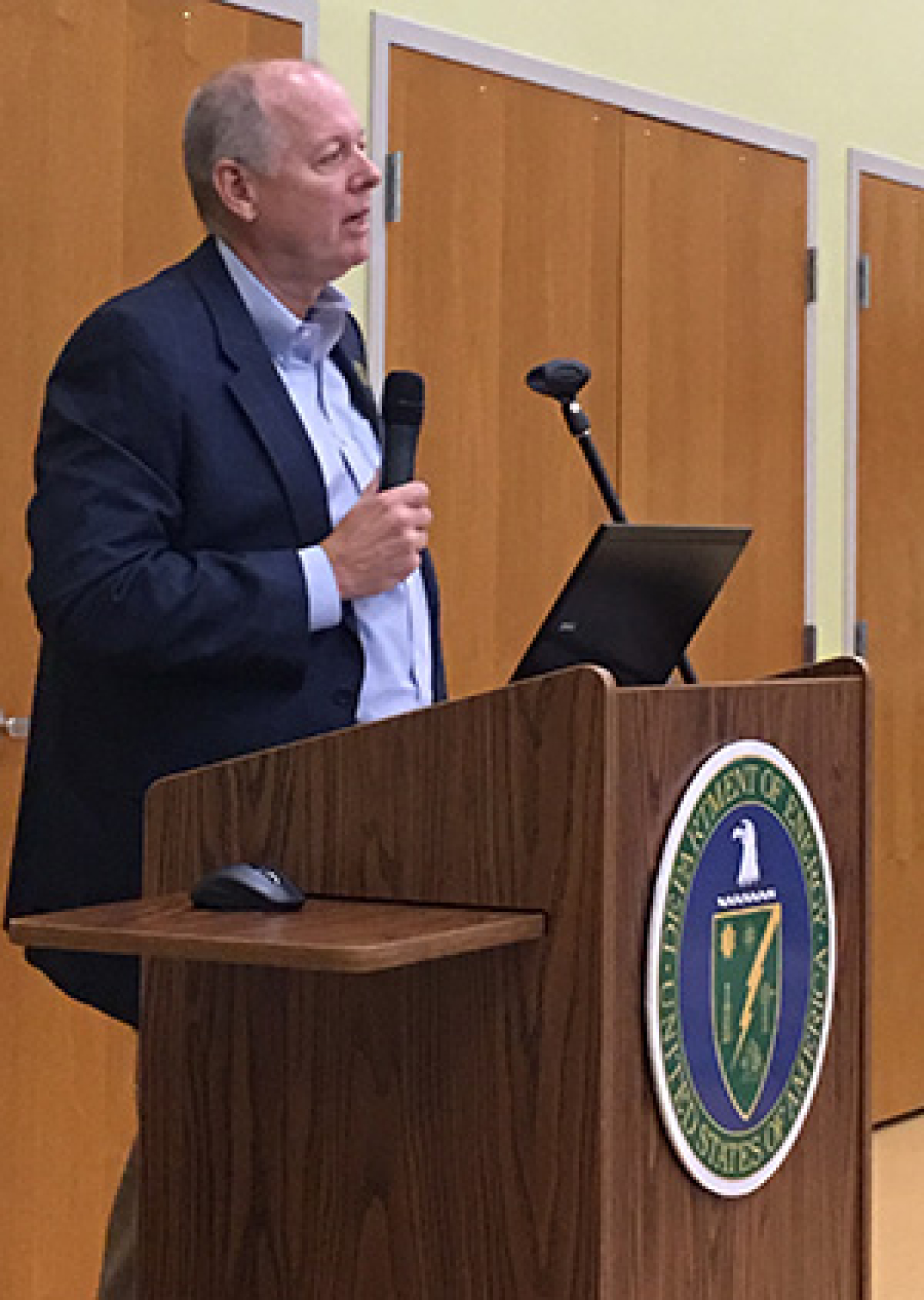Participants in the 10-year anniversary celebration of the Fernald Site cleanup completion.

Savannah River Site (SRS) Manager Jack Craig speaks at the celebration marking the 10-year anniversary of the Fernald Site cleanup completion. From 1995 to 2000, Craig was the director of Fernald Environmental Management Project, responsible for the management of all facilities decommissioning, radioactive materials management, environmental restoration, and public involvement.
A view of the Fernald Preserve.
Before photo of the Fernald Site cleanup.
After photo of the Fernald Site cleanup.
HAMILTON, Ohio – DOE hosted an event Oct. 29 marking the 10th anniversary of the Fernald cleanup, drawing former site workers, neighbors, regulators, activist groups, contractors and others to celebrate the project’s successful completion a decade ago.
EM and contractor Fluor Fernald finished the project in 2006 at a cost of $4.4 billion — saving more than $8 billion — and 12 years ahead of the original estimated completion date. It was one of the largest environmental cleanups in U.S. history at the time.
Close to 400 people attended activities for the celebration, “Weapons to Wetlands: A Decade of Difference” at the Fernald Preserve Visitors Center. Guests noted a spirit of pride and cooperation that helped make the cleanup a success. Building demolitions, soils mitigation and other work transformed the 1,050-acre former uranium production plant into the Fernald Preserve and its natural wetland, prairie and forest habitats.
“I’m proud to be part of the success of this project. This was the largest cleanup project in Ohio’s history and the largest waste shipping program in the Department of Energy,” said Dennis Carr, former deputy site manager with Fluor Fernald. “Our key to success is that no corners were cut and no rules were changed for us. It was all about the incredible people sitting in front of you and beside you that got this job done and we appreciate everything you did.”
Speakers included representatives from DOE, current and former stakeholder groups, site contractors, regulators involved in the cleanup and the Cold War Patriots. That group advocated for the creation of the National Day of Remembrance for nuclear weapons program workers, which takes place Oct. 30 every year.
“The Fernald Preserve is an amazing place. I see how this site has grown, changed, and healed itself and we did it all together,” said Lisa Crawford, a former Fernald Citizens Advisory Board member with Fernald Residents for Environmental Safety & Health (FRESH). “The Fernald Preserve has taken us back to our roots and has become a huge community asset that carries on the legacy of Fernald.”
Participants in the celebration toured the site by bus, viewed Cold War history exhibits at the visitors center and walked miles of trails now available to the public with scenic views of restored land.
“We’re here today to celebrate what is truly a unique cleanup project — a great partnership that involved a lot of creativity, perseverance, pragmatism, and, most importantly, a team that never lost focus on the end goal. The Fernald cleanup is the gold standard of the cleanup mission of this country,” said Tom Winston, who is retired from the Ohio Environmental Protection Agency (Ohio EPA). “In the ‘90s we set a tone that we had a focus on a timely and successful cleanup at Fernald and that is the message we sent to the Department of Energy. The Department of Energy responded that this was a site worth investing in and a site that could show a skeptical public that this was a program that was worth investing in.”
The environmental cleanup was carried out in accordance with legally binding agreements that directed site cleanup and established final remediation standards. The agreements were developed by the U.S. and Ohio EPAs, DOE and the public. DOE also worked closely with the Fernald Citizens Advisory Board, FRESH, local elected officials and plant neighbors to develop and execute cleanup plans.
Cleanup achievements by DOE and Fluor Fernald and its partner companies Jacobs Engineering, Nuclear Fuel Services and EnergySolutions, included:
- Eliminating the world’s largest source of radon gas by safely removing and treating radioactive waste from three large concrete silos and shipping it offsite for disposal;
- Dismantling 323 buildings, including 10 major uranium production complexes and administrative structures;
- Excavating and shipping 1 million tons of waste from six waste pits;
- Building an on-site disposal facility to hold 3 million cubic yards of contaminated dirt and debris from facility demolition;
- Treating a 225-acre plume of uranium contamination in the underlying aquifer;
- Removing over 100,000 drums of waste and 31 million pounds of uranium product from the site; and
- Designing, building, operating and dismantling over $300 million in waste treatment and handling infrastructure.
The Project Management Institute named the Fernald Closure Project its 2007 Project of the Year, citing superior project management and project controls employed in the safe cleanup and closure efforts by DOE and its contractors.
Fernald was transferred to DOE’s Office of Legacy Management in 2006, and the mission changed from environmental remediation to ongoing groundwater cleanup, maintenance of an onsite disposal facility, ecological restoration, environmental monitoring and public access.
